6DJ8/ECC88 Tube Shootout, Part 1
by Steve Graham
I pitched the idea of a 6DJ8 shootout to Noam shortly after I read Tim’s 6L6 comparison. Not that my gear uses any 6L6’s, but being a tube nerd I read it anyway; when I saw the number of views Tim got I thought, I’d like to try and beat him at that game.
The 6DJ8 and the European equivalent ECC88 were introduced to North America in 1957 by Philips of Holland through their Amperex division in the USA. Originally intended for RF applications in the tuner sections of television sets, it was pressed into service by Tektronix for use in their built-like-battleships oscilloscopes.
The 6DJ8 came to the attention of the audio community when used in FM tuners, but what really cemented its’ audio status was when Marantz used it in the Model 9 power amp. Through the years the 6DJ8 has been employed in many seminal high-end designs from Audio Research Corp. to Theta, forerunner of Theta digital.
When we speak of the 6DJ8 and ECC88, the equivalents in this group include the 6922, E88CC, 7308, E188CC and a few others of CV designation as well.
Yeah, I know: skip the history lesson and get to the shootout. Actually to guys of my generation that grew up in small towns or in the countryside, something made of glass and ‘shooting’ usually involved target practice with a .22 rifle and a few bottles or jars. At one point in my checkered past an old black and white TV picture tube was involved in a shootout.
I refer you to my “Battle of the Cheap Line Stages, Part 1” for the equipment used in this “shootout.” The N-F-P line stage makes for, in my opinion, a good test bed for these tubes. Loop feedback in a line stage, which to my way of thinking tends to not only nobble sound quality but also gloss over tube differences, is not employed by the Aikido circuit in the N-F-P. The N-F-P also treats its tubes gently, running them well within their power dissipation limit. In case you haven’t read the N-F-P review, I think it’s a real overachiever, offering audio quality far greater than its cost would have you expect.
As the N-F-P is a low-cost, high-value design, I’m purposely limiting the cost of the tubes reviewed to about US $50 each. I can’t justify spending as much on a set of expensive NOS tubes as the linestage itself costs. So this test will exclude the $100 up to truly ridiculous multi-hundred dollar NOS offerings. I will however try a set or two from my NOS stash just for comparison purposes. For a comparison of (mostly expensive) NOS tubes, I refer you to Joe’s Tube Lore of a decade or so ago on the Audio Asylum site. (link) From personal experience, I can’t say I’m in total agreement with Joe’s ranking. I have heard his favourite tube, an early Amperex 6922, and to me it just sounded wrong.
I’m a firm believer that tubes especially, and hifi gear in general, need burn-in time to sound their best. I’m running all of the tubes compared for about 100 hours (playing music) before seriously listening to them.
At Noam’s suggestion, I’ll assign a performance number to each tube. This is somewhat arbitrary and doesn’t tell the whole story, so please read the full description. Also, a rating number is not an absolute. If a tube rates a 70. for instance, that doesn’t mean that it’s 70% good and 30% bad. 70 is just a number. Your ranking in a different piece of equipment could be different, but I think the performance l describe can be projected on to different components. See next paragraph.
One more thing before we get to the tubes. The elephant in the room with all tube comparisons is that the results are most valid on the piece of equipment they were compared on. That being said, a few years ago I was tube rolling a bunch of mostly NOS 6DJ8s through a headphone amp, and discovered something quite interesting. The amp I was primarily using was an Aikido where the 6DJ8 is used in the cathode follower output stage. I had the brief loan of a Shiit headphone amp that uses the 6DJ8 as a gain tube. Nonetheless, I found that the general characteristics of any given tube would carry over from one amp to the other.
Many thanks to Thetubestore.com for the loan tubes that will be evaluated in Part 2 of this shootout. These comparisons would not be possible without their generous support. http://www.thetubestore.com/
I’m going to write this as I listen to the tubes so it might seem like a bit of a meandering, real time journey. The first tubes in the shootout were compared before the ones from Thetubestore arrived…but once I get the bit between my teeth, I’m off and running.
The baseline tube: JJ E88CC Slovakia
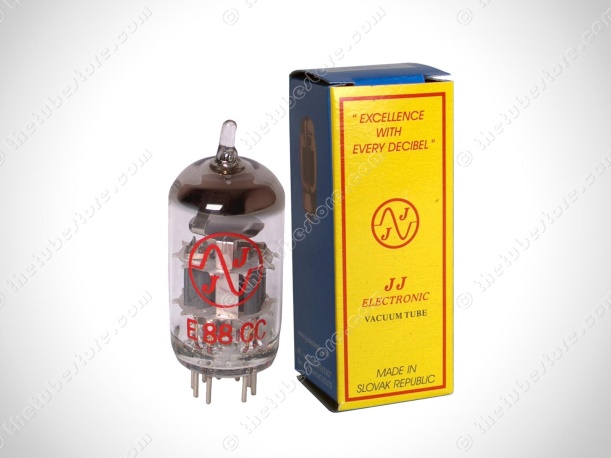
Current production. Thetubestore.com $14.95 US ~$20 Cdn.
These are my own tubes that I purchased from Thetubestore.com a few years ago. When purchased, I wasn’t that enamoured with them and stashed them away. But I got them out for the N-F-P build and now I find I quite like them. The price is reasonable and will set you back not much more than $100 Cdn. for a quad, including shipping and tax.
Sound: These tubes sounded good with only about 50 hours on them, and even a bit better still once they passed the 200 hour mark. They’re not the ultimate in bass extension but their bass is tuneful and keeps up with the music. The midrange and treble of these tubes is their strong point. Vocals are well portrayed, but smoothly so, not thrust forward. The highs are detailed and clean without being etched or spitty. There is a nice top to bottom consistency with this tube. Everything from the low bass through the very high treble all seems to “singing from the same song book”, i.e. no part of the audio spectrum seems to be disjointed or disconnected from the rest. The sound is not homogenized though; musical details are laid out clearly, yet not in a fatiguing way. Not a “showy” tube, but a musical one that’s easy to live with in the long run.
Conclusion: A no-brainer way to re-tube the N-F-P and an inexpensive tube to take a chance on if your gear uses 6DJ8’s or equivalent.
Recommended.
The above was written from my memory of the sound when I built the N-F-P. I’ll revisit this tube after the Matsushita and assign a number to it then.
Matsushita 6DJ8 Japan
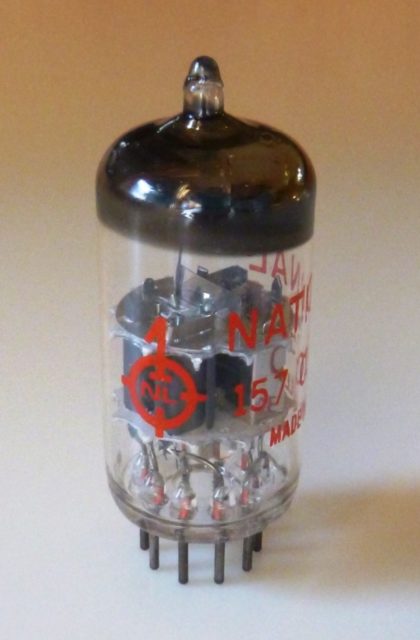
NOS $40 US, ~$55 Cdn.
These tubes are from my personal stash as well. I purchased them 10 years or so ago, for about $4 US each(!). These tubes, labeled National, as well as the NOS available currently, have Tektronix part numbers but they were made in Japan by Matsushita, the parent company of Panasonic. I put them in the N-F-P, had a quick listen for a minute or two and then left them to burn in as per my usual practice.
Sound: At first listen (before the four day burn in) these sounded a little disjointed. But as I’ve learned, this usually changes, mostly for the better, once about 100 running hours have accumulated. Such was the case here. The Matsus have a brighter treble than I remember from my time with the JJ’s. This is a bonus on well-recorded material, but a detriment on recordings that are too hot in the treble. The midrange is clean and nicely presented. The bass is tuneful, but seems slightly reticent compared to the mids and highs. The dynamics of this tube is its strong point. The initial pluck of a bass guitar string and the initial hit of a drum stick on the head of a drum has a “startle factor” that I find appealing. This isn’t followed up with the deep bass “whomp” I’d like to hear, unfortunately.
Conclusion: An interesting tube with some appealing attributes. A little light in the bass and hot in the treble for my tastes.
Would I recommend this tube? Hard to say. I’ve seen them from a US based vendor for $40 each. By the time you get four into Canada, pay the shipping, taxes and exchange you’re looking at almost $300 Cdn. In this application, and for the budget I’d like to adhere to…no, not recommended. Unless of course, you think they might be your ticket to musical bliss and have $300 you’re willing to gamble with.
Rating: 50 Not Recommended due to both performance and price.
JJ E88CC Slovakia (Memory Refresh)

Current production. Thetubestore.com $14.95 US ~$20 CDN.
I put these back into the N-F-P just after writing about the Matsushitas. These are almost the inverse of the Matsus. The bass is stronger and deeper, but it doesn’t quite have the startle factor I found appealing in the Japanese tubes. There is the deeper “whomp” of bass guitars and bass drums that I like, but it is a bit rounded and indistinct. The highs are somewhat recessed compared to the Matsus, and this is a benefit on recordings with hot high frequencies. In some ways these tubes now sound to me a bit “vintage”. By that I mean, they aren’t the most incisive sounding. They are smooth and easy going, sometimes a bit too much so.
Conclusion: Its’ low price and appealing smoothness combined with its bass “whomp” (I’m a fan of whomp, provided it’s reasonably tight), makes this still an easy tube to recommend. But I’m on the hunt for a tube (a reasonably priced one hopefully) that will combine the best of the JJ with the best of the Matsushita.
Rating: 65 Recommended.
Amperex 6922 PQ USA
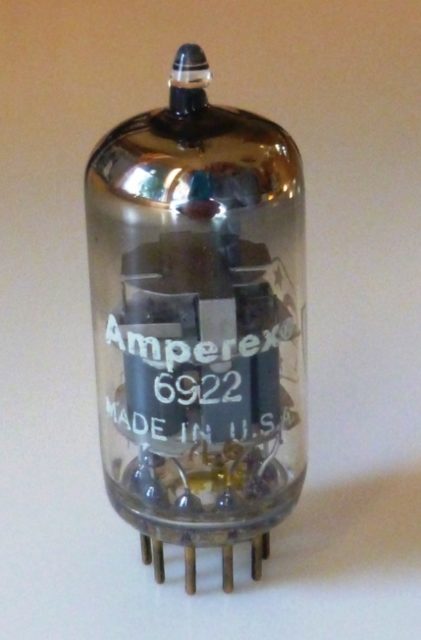
NOS $100 US or more, ~135 Cdn. or more.
I purchased these 1960’s vintage NOS tubes about 10 years ago, for about $50 US each. I’ve seen them from a few US-based vendors starting at $100 and rising astronomically from there. I could never quite come to terms with the sound of these tubes in the Musical Fidelity F22 line stage I was using at the time. I tried them again recently in my Aikido headphone amp, and though compelling at first with lots of detail, great bass and ear-grabbing dynamics, they soon became fatiguing with their in-your-face midrange and treble presentation.
Sound: In the N-F-P these tubes display many of the properties I remember from previous listening experiences. The bass, though not quite as full and rounded as the JJ’s, is more taught and tuneful. It also has good pace and propels the music. These tubes are dynamic like the Matsus, but go deeper. The midrange and treble, however, are a letdown. The mids are harsh and not that musical. The JJ’s are better in this regard. The highs are too bright and make these tubes real ear burners, especially with bright recordings.
Conclusion: I couldn’t recommend these tubes even if they were selling for 20 bucks apiece. At the silly-money prices asked, don’t bother; you’re not missing any of the sonic glories of yesteryear by not hearing these tubes. They were meant for use in oscilloscopes and other instrumentation applications. Analytical, and not in a good way, is the best descriptor for these tubes. Best avoided, use your money to buy records instead.
Rating: 35 Not recommended. The performance is dreadful and the price is insane.
Tesla ECC88 Czech Republic

NOS. Price: see text.
These tubes were acquired in trade from a fellow I used to work with. I loaned him a pair of the Matsushita tubes to try in his headphone amp. He liked the Matsus and wanted to keep them, so we struck a deal; four of the Matsus in trade for four of these Teslas. These are the plain vanilla Tesla ECC88’s. If memory serves, my former colleague bought these from the USA and landed them here for about $110 CDN. This was before the US Postal Service introduced their money grab rates on mail going out of the US. It used to be that Canada got a better deal than parcels headed to say, Australia. Not anymore. It still rankles me to think of the $102 US it cost me to get two transformers I paid $175 for ($277 total with shipping) sent from Edcor in New Mexico. And no, before you ask, there wasn’t an equivalent Hammond that would do the job. I’m just sayin’, some of the tube prices on US websites may seem appealing, but do the math before clicking “BUY”.
Sound: I really like the sound of these tubes. These were the tubes I first tried in the N-F-P and I’m sure they helped convince me it was a contender in the high value line stage “battle”. I find that my sonic opinion of them versus the JJ’s needs to be modified slightly. In my defence I’m going to plead that the N-F-P was not fully broken in when I heard it with these Teslas. Now that I’ve heard them on the same day as the JJ’s I feel more confident that the latest bit of listening is a truer valuation. The bass of these tubes is not quite as deep as the JJ’s, but it has noticeably better definition. They’re getting close to the Amperex 6922’s in this regard, but they don’t have the very low bass extension and snap that the Amperex has. In the midrange and treble they have the Amperex beat by a mile though. The Tesla is clear in the midrange and treble, not quite as smooth as the JJ’s, but listenable all the same. A nice tube, I think I got the better end of the bargain in the trade for these. A good alternative to the JJ. I expect to receive Tesla tubes very similar to this from Thetubestore, I’ll compare them as well.
Conclusion: A fine tube and the most worthy alternative to the JJ in the shootout, so far. Whether your preference would be for the Tesla over the JJ, or vice versa comes down to taste, source material and partnering equipment. I prefer the Tesla marginally more than the JJ, but the numerical difference is small enough it could go either way depending on other system variables.
Rating: 70 Recommended.
Even though the Teslas are NOS, there must be lots of them around. The prices are still reasonable and they are available from several vendors. If you find some you like, buy extras; they won’t get any cheaper. Some Tesla lore that I shared in part 1 of my line stage opus bears repeating: the best Teslas have factory code 32 on them, see the picture below. The factory code 37 tubes are not quite as good as the 32’s but still decent tubes and worthwhile buying. If you are offered tubes with factory code 25, politely decline, they have been disappointing in my experience and a waste of money.
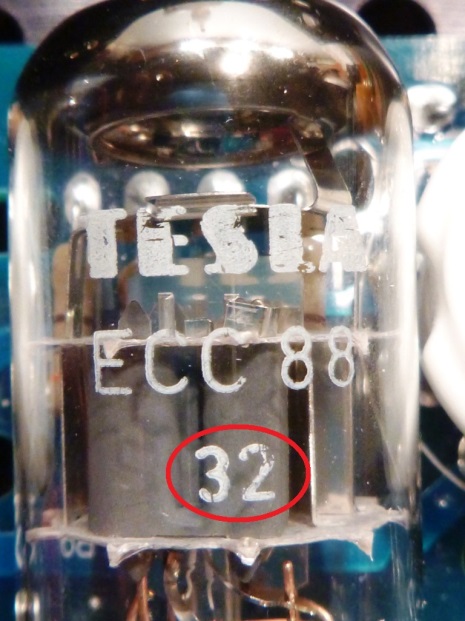
File under: Be careful what you wish for. I had initially asked for four sets of tubes to evaluate from Thetubestore but head honcho Jon is tentatively offering about eight sets, Jeez Louise. It would seem ungracious to decline, though I did demur on one particular NOS tube, which shall remain nameless, as I’d never had a positive listening experience with it in the past.
While I wait for a big box of tubes from Thetubestore.com to appear on my door step, I’ll take you on a tour of the tracks I used in this shootout. I still think of the .22 and the picture tube every time I type “shootout”.
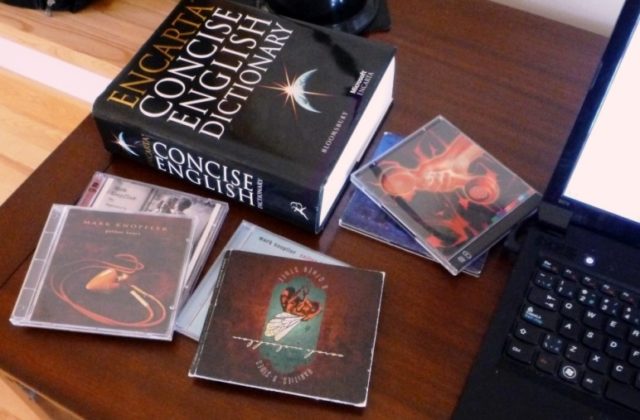
Peter Gabriel, Secret World Live: Digging in the Dirt. A decently recorded live album, and this particular track has great bass and dynamic drum sound. The drum hit at 1:25 is a good test for impact, speed and bass extension. In absolute terms the recorded sound on the album is OK, but not great. The way the musically dense passages and Gabriel’s voice is handled make it a stress test for components.
Sarah McLachlan, Rarities, B-Sides & Other Stuff: Full of Grace & Song for a Winter’s Night. McLachlan’s voice is recorded quite “hot” (it’s very sibilant) especially in Winter’s Night. I usually dislike cover songs; just write a new song for crying out loud. I’ve damn near broken the power button on my car radio from the scramble to turn it off every time that hideous cover of American Woman comes on. I like Song for a Winter’s Night better than the Gordon Lightfoot original though. How the “hot” vocal is treated is something I listen for, and the Mellotron sounds cool as well.
Loreena McKennitt, An Ancient Muse: The Gates of Istanbul, Kecharitomene, Caravanserai. The first minute or so of Gates and Caravanserai are good detail testing passages. As McKennitt’s voice is almost always recorded too hot, it’s a test to see how much a component, or tube in this case, adds insult to injury. If a past or future lottery multi-million dollar jackpot winner is reading this, please do two things for the betterment of humankind. First: Make a very large donation to your local hospital. I’m talking a million dollars, minimum. You won’t miss it. Second: Buy Loreena a tube microphone, preferably a classic Telefunken or something like that, and a really good A to D converter. Sick people and music lovers will think you a star!
Mark Knopfler, The Rag Picker’s Dream, Golden Heart, Sailing to Philadelphia: Why Aye Man, Hill Farmer’s Blues, Golden Heart, What It Is, Prairie Wedding. Though the sound quality of Knopfler’s work is a bit variable, it’s at least OK, and often quite good. He always seems to weave three guitar parts, usually at least two simultaneously, through his songs. Sorting these out is a test of a components detail resolution. Bass and drums are usually recorded well, and will test a components “whomp” factor, as I discussed above. My “emotional connection” test is the Hill Farmer’s Blues track. It’s about a man trying to scratch out a living who discovers that his partner has been unfaithful. How well I connect with this track is an even more subjective evaluation than other listening tests. I don’t put a lot of weighting on this test but the amount of “connection” I feel as the intensity of this track builds, and then subsides, is an indicator of a component’s “rightness” in my mind. I think Knopfler is one of the guitar “gods”, who wouldn’t want to play like him? If only most of his songs weren’t quite so dark.
My formative years were the era of the guitar hero, and I make no excuses returning to that. Other artists I listen to that are not really part of the formal evaluation process, but others I spin are Stevie Ray Vaughan, Bonnie Raitt, and Pat Metheny, to name a few. I prefer the early to middle period Metheny, the latter works of the last ten or so years, not so much. Metheny is to the jazz world what Rush is to rock; you either love it or hate it. Not that I hate Rush, but their songs that I could occasionally listen to would form about a twenty minute compilation. The other band I’ll sometimes throw on for fun is Canada’s best, almost-famous prog rock band: Saga.
It has just been confirmed from Jon at Thetubestore that I can expect six sets of tubes. My customary four day, approximately 100 hour, burn in cycle will take a while. Gee, I’m glad I didn’t ask for power tubes – they would really run up my electricity bill.
While waiting for delivery of tubes, I decided to experiment by putting the JJ’s into the gain section (V1 and V2) of the line stage and the Teslas into the output section (V3 and V4). If you are a circuit geek like me, see part 2 of my line stage opus for a schematic of the Aikido board used in the N-F-P. I want to see if I’ll get the best of both tubes or perhaps it will turn out to be the worst of both.
JJ/Tesla Combination “A”


JJ E88CC (Slovakia) in the gain section, Tesla ECC88 (Czech) NOS in the output section
Sound: 2/3 the properties of the JJ and 1/3 Tesla. The Tesla has tightened up the loose-ish bass of the JJ, and the mids and treble are a bit more incisive as well, but not harsh.
Conclusion: An appealing combination, and the best overall sound so far. Perhaps I can do better still, so I’m going to switch the Teslas to the input and the JJ’s to the output.
Rating: 75 Recommended.
Tesla/JJ Combination “B”


Tesla ECC88 (Czech) NOS in the gain section, JJ E88CC (Slovakia) in the output section
Sound: Now this is interesting. The mids and highs are a bit more forward, which makes the vocals of the McLachlan track Song for a Winter’s Night, and McKennitt’s Caravanserai, a bit spittier. I believe this is a truer representation of how these tracks were recorded and mixed. The bass seems a bit tighter and deeper than the previous orientation of these two tubes. When the bass comes in, at about the four minute mark of the McKennitt Caravanserai track, it lopes along appealingly with good “bounce”. It has good initial pluck of the bass guitar string, the way the Matsushita has, but this combination has the purr of the low bass to back it up, which the Matsu doesn’t. The detail on the stringed instruments at the beginning of this track is nicely portrayed. The quite percussively played stringed instruments at the beginning of The Gates of Istanbul are engaging as well, and when the bass comes in at about 0:35, it has nice pluck and “roll” to it. The bass and drums of Knopfler’s Golden Heart have force and dynamics. I don’t mean to give the impression that the bass is all these tubes do well. The bass is an excellent foundation to the clean clear mids and highs and all three “play” together quite well and the resultant sound is coherent. The symbiosis of these two tubes is really quite surprising and the overall performance of the two together is better than either one individually. This combination gets closer to my ARC Ref 3 in extension at the frequency extremes, if not in absolute detail and spatial performance.
Conclusion: This is a winning combination of tubes in this piece of equipment. I could see an owner of this line stage with two JJ’s and two Teslas, picking the orientation (Teslas first or JJ’s first) that suits the rest of his or her system, source material and tastes…and then screwing the top down and just enjoying music. The only other thing he or she would need to do is buy about three more pairs of each, to future proof the line stage part of their system.
Rating: 80 Recommended.
Pondering this development, it makes perfect sense, in a first order approximation kind of way. Any one tube’s characteristics, whether it be good, bad or something in between, will be magnified when cascaded together, as they are in this line stage. If a tube has undesirable characteristics, however you might judge it, then it only stands to reason that two together will sound worse. The flip side of the coin would probably invoke Murphy’s Law. Two “good” tubes cascaded together might just dilute their “goodness”. I’m just thankful that there is essentially only one manufacturer of the 6H30 tubes used in my ARC line stage, or I’d never sleep at night.
Please excuse my diversion into tuning from the task at hand, though it does go to show that sometimes you need to think outside the, ahem, tube, and try the improbable or unlikely. Something good just might happen.
If this was my line stage and I was trying to optimize it, I’d probably stop right here. Who am I kidding; I’d carry on with all the goodies anticipated from Thetubestore.
This, however, is not about me, or this particular piece of equipment. I won’t be doing any more mixing and matching though. The potential combinations would be endless. I think what we can take away from this is that it’s potentially beneficial to experiment.
Mullard Mitcham ECC88
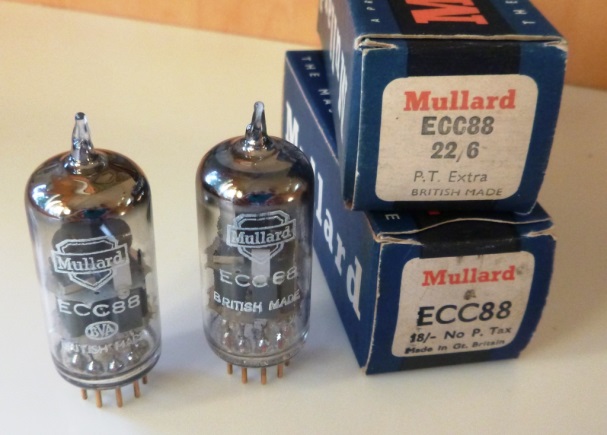
NOS Price: About $30 each fifteen years ago, see text
These tubes are on loan from my audio pal Dougie. I’ve mentioned Dougie before. Every audiophile should have a friend like him. He’s always willing to give things a listen and lend things out too. The current case in point is these NOS treasures that Dougie acquired some years ago. It was not without some reluctance that I asked to borrow these. I know from personal experience that NOS tubes, Mullards especially, can go supernova with little or no provocation. These tubes were made in the Mullard Mitcham factory in 1958. I’d be willing to bet that these tubes are older than the median age of Wall of Sound followers. They have ECC88 printed on the glass but when you decipher the etched factory codes they are E88CC’s. They also have gold pins, like later Mullard E88CC tubes. As far as price, in today’s market I’d say they’d probably go for about $200 US for the set of four.
Sound: These are the Colin Firth, or more accurately for their vintage, the Cary Grant of tubes; the restrained English gentleman we are used to seeing these actors portray. If by that you think I mean these tubes are nice, but a bit boring, that’s exactly the impression they made on me. The mids are smooth, the bass reasonably extended but not very firm, and the highs are on the soft side. These tubes are, in most ways, the polar opposite of the brash American Amperex 6922. Listening to these Mullards is pleasant, but not engaging. The bright vocals on the McLachlan track Song for a Winter’s Night (and McKennitt’s Caravanserai), sound smoother, but this is at the expense of instrumental detail. The sound is a bit disjointed as well. The bass, mids and treble don’t quite seem to be “playing together” as well; it seems as if the musical parts of recordings are pasted together without the “wholeness” of a performance that I’m looking for. Roughly similar, but more engaging and coherent sound, can be had for a lot less money in the JJ E88CC.
Conclusion: Not a bad sound, but not engaging either. Better sounding tubes are easily available for much less.
Rating: 50, due to their sound and expense. Not recommended unless you come across them for about 20 bucks each, which is highly unlikely.
Summing Up (so far):
Big buck NOS is no guarantee of sonic bliss. Good sounding tubes are available at real world prices; options exist for great sound on a budget. I can’t wait for the big box of tubes from Thetubestore.com to show up.
Next Time:
More tube evaluations will continue in part 2. No more unreasonable or unobtainable NOS though. Only real-world tubes available for purchase by anyone with a credit card and an understanding partner.

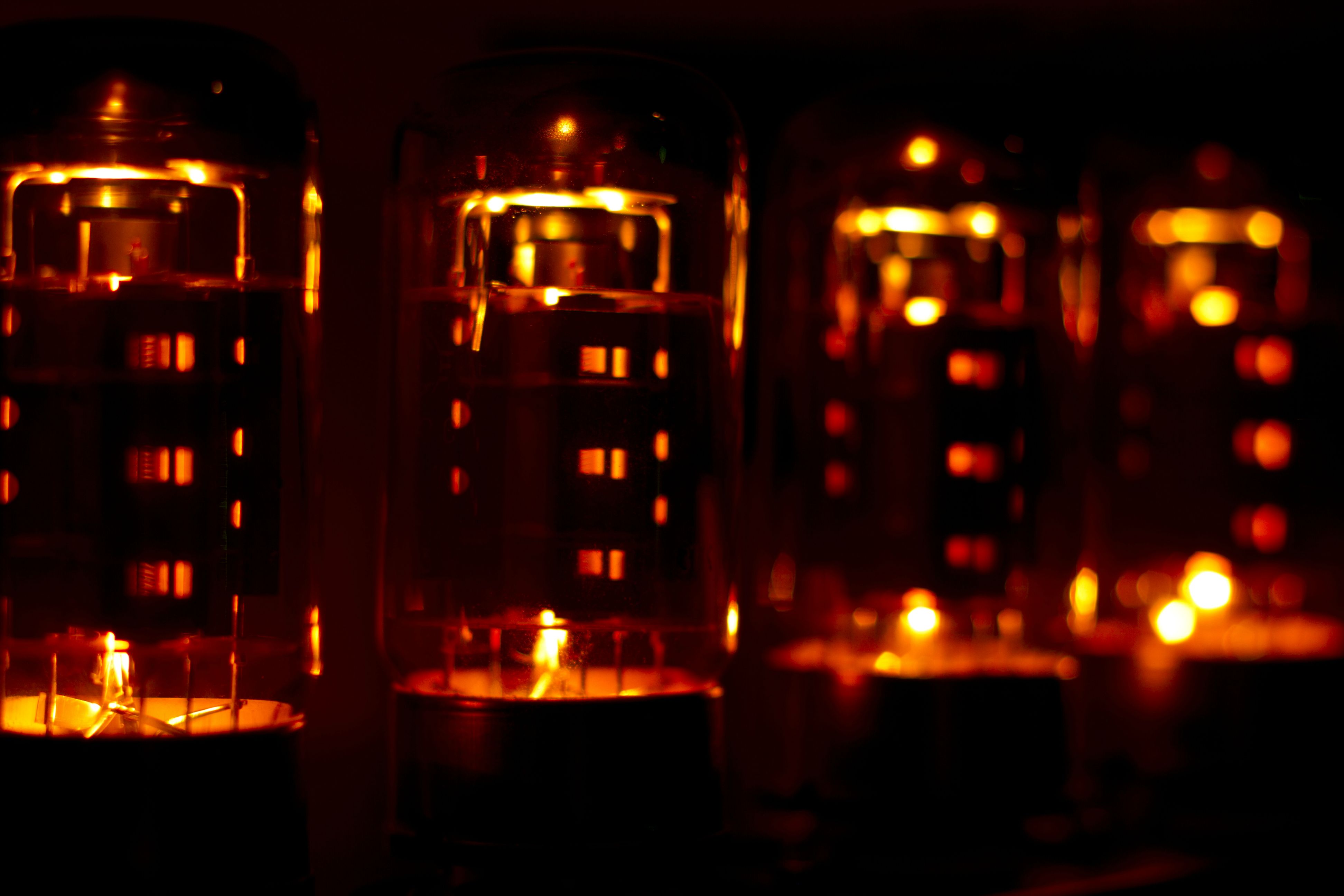
Hi,
very instructiv.
I have a tesla factory code 34. It is as good as the factory code 32 ? Come from roznov too ?
Cheers.
I have always loved my RCA 6DJ8 in hybrid amp they had bass and sparkling involvement with speed.
But did last to long , maybe 6 months going hard.
Thank you for your interest in Wall of Sound.
Tesla factory code 34 is not one I’ve seen before, but I am hardly an expert on the subject. It seems the primary factory codes for Tesla ECC88 and E88CC types are 32 and 37. It could be that for whatever reason they are from either factory 32 or 37 but have been labeled 34. The other possibility is that they might have been made by another manufacturer entirely but labelled as Teslas. I suspect this was the case with the factory code 25 Teslas I mentioned in the article.
I believe the person that owns Tubemonger.com (http://www.tubemonger.com/default.asp) posts to one of the tube forums(https://www.audioasylum.com/audio/tubes/bbs.html) and an enquiry there might receive an answer.
The primary difficulty with performing an internet search on Tesla now is that most results refer to the electric car manufacturer.
I’m sorry I can’t be more helpful.
Regards, Steve Graham
Hi,
I happened to find this opinion on 6DJ8/6922/E88CC tube types, and with all due respect for the opinion of others, I was amazed when not recommended Amperex 6922 PQ USA and recommended JJ E88CC and Matsushita/National 6DJ8.
Included in my audio system is a Manley Steelhead phono stage and a
Aesthetix Calypso tube preamp …both use two 6922 tube types…
I have a large collection of tubes because besides my audio system I have several vintage guitar amplifiers, Fender, Marshall, Mesa Boogie and Ampeg SVT Bass amps, Ampeg SVT 3 PRO, Trace Elliot, etc, etc and all to valves…
As for the 6922 tube types I have Amperex 6922 PQ and Philips 6922 SQ Gold pins made in USA and Holland with white and orange label, Philips E188CC SQ gold pins (other championship) RTC E188CC gold pins, Miwatt Dario E88CC gold pins, Amperex Bugle Boy, Telefunken E88CC, Siemens E88CC/6922 etc, etc …
Compare a 6922 JJ tube vx Amperex 6922 PQ USA in my modest opinion has no comparison … I am a musician and “audiophile” and I have a collection of more than 2000 vinyl records and I trust my ears…
A friend of mine has a BAT preamp and uses 4 National 6DJ8/ECC88 tubes… replaced by 2 Amperex 6922 PQ and 2 Philips 6922 SQ Gold pins (tubes are identical in sound)…the difference was notorious for much better sound quality and you do not have to be an “expert” just have ears…
In my modest opinion, and for those who do not want to spend money, JJ Tube is a decent maybe among the best of the current production of 6922 tubes, but has no comparison with Amperex 6922 PQ Tube or any other NOS tube …
Everyone has the right to their opinion …
“Rating: 35 Not recommended. The performance is dreadful and the price is insane ”
This evaluation is complete nonsense…
I use JJ Tubes on my guitar and bass amps. In the guitar amplifiers in position V1 use NOS tubes … Amperex, Philips, Siemens Telefunken depending on the sound I want to achieve … JJ Tubes never …
Regards,
Paulo